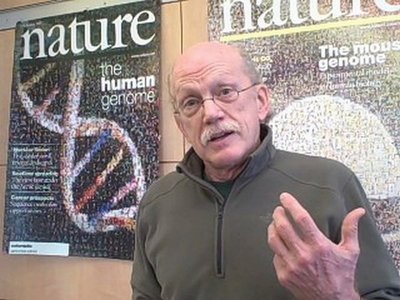December 22, 2010
UW Medicine scientists among international consortium of researchers to conduct first-ever analysis of roundworm genome
Watch a video with Dr. Bob Waterston, professor and chair of genome sciences, describing the analysis of the roundworm genome.
The first-ever integrated analysis of the molecular processes that control genome function in an animal — in this case, the roundworm — has the potential to speed understanding of the molecular processes in human cells, according to a study in the Dec. 24 issue of Science authored by an international group of scientists that includes UW Medicine researchers.
“Our in-depth studies of the worm genome have revealed and refined the structure of thousands of protein coding genes and helped to define when in the life cycle and in what cells these genes are used.” said Dr. Robert Waterston, UW professor and chair of the Department of Genome Sciences and one of the authors of the paper, titled “Integrative Analysis of the Caenorhabditis elegans Genome by the modENCODE Project.”
Waterston is a member of the model organism ENCyclopedia Of DNA Elements (modENCODE) Consortium, the international group of scientists who authored the paper and are funded by the National Human Genome Research Institute (NHGRI), part of the National Institutes of Health. A companion Science paper reports findings of a similar study in the fruit fly (Drosophila melanogaster), and more than a dozen companion modENCODE papers are published online in the journals Nature, Genome Research and Genome Biology.
The roundworm and the fruit fly genome sequences were initially sequenced alongside the Human Genome Project and are routinely compared to the human genome sequence in experiments that rely on millions of years of evolution. The authors found that particularly important stretches of DNA in the genome are “conserved,” or retained, throughout evolutionary history.
“The deep evolutionary connection between flies, worms and humans makes research in these model organisms highly relevant to human biology,” Waterston said.
An internationally recognized scientific leader in gene mapping and DNA sequencing, Waterston played a crucial role in the sequencing of the roundworm genome, the world’s first of a multicellular organism, and later in the mapping and sequencing of the human genome. He has chaired the UW Department of Genome Sciences and held the William Gates III Endowed Chair in Biomedical Sciences since 2003.
“When we completed the worm genome sequence in 1998, we could only recognize the function of a fraction of the genome,” Waterston said. “These studies combine to reveal more than 80% of the functional elements — a dream come true.”
The researchers examined the organization and structure of DNA and its associated proteins, called chromatin, in the cells throughout the life stages of each organism. Strikingly, both groups — those studying the worm and those studying the fly — discovered specific chromatin signatures associated with the regulation of genes in their respective organism. Unique chromatin signatures were associated with distinct regions of the genome that either turn genes on or off.
“By correlating the chromatin signatures with the patterns of gene expression,” Waterson said, “we were able to predict the actions of the genome in different states, providing a powerful means for understanding how genomes work.”
“These findings will enable scientists everywhere to carry out experiments in fruit flies and roundworms to better understand the relationship between molecular and biological activities in these animals,” said NHGRI Director Eric D. Green, M.D., Ph.D. “What we learn from these model organisms will contribute greatly to our understanding about the genomic basis of health and disease in humans.”
Other authors are from Fred Hutchinson Cancer Research Center, Seattle, WA; Cold Spring Harbor Laboratory, Cold Spring Harbor, NY; Dana-Farber Cancer Institute, Boston, MA; European Molecular Biology Laboratory, Heidelberg, Germany; Harvard School of Public Health, Boston, MA; Lawrence Berkeley National Laboratory, Berkeley, CA; Max Planck Institute of Molecular Cell Biology and Genetics, Dresden, Germany; National Human Genome Research Institute, Bethesda, MD; New York University, New York City, NY; NimbleGen Systems, Madison, WI; Ontario Institute for Cancer Research, Canada; Sloan-Kettering Institute, New York, NY; Stanford University, Palo Alto, CA; State University of New York at Stonybrook; University of Toronto, Canada; University of California- Berkeley, University of California- San Diego, University of California- Santa Cruz; University of Cambridge, Cambridge, UK; University of Michigan, Ann Arbor, MI; University of North Carolina; Vanderbilt University, Nashville, TN; Weizmann Institute of Science, Rehovat, Israel; Yale University, New Haven CT.
###
Tag(s): genomics


